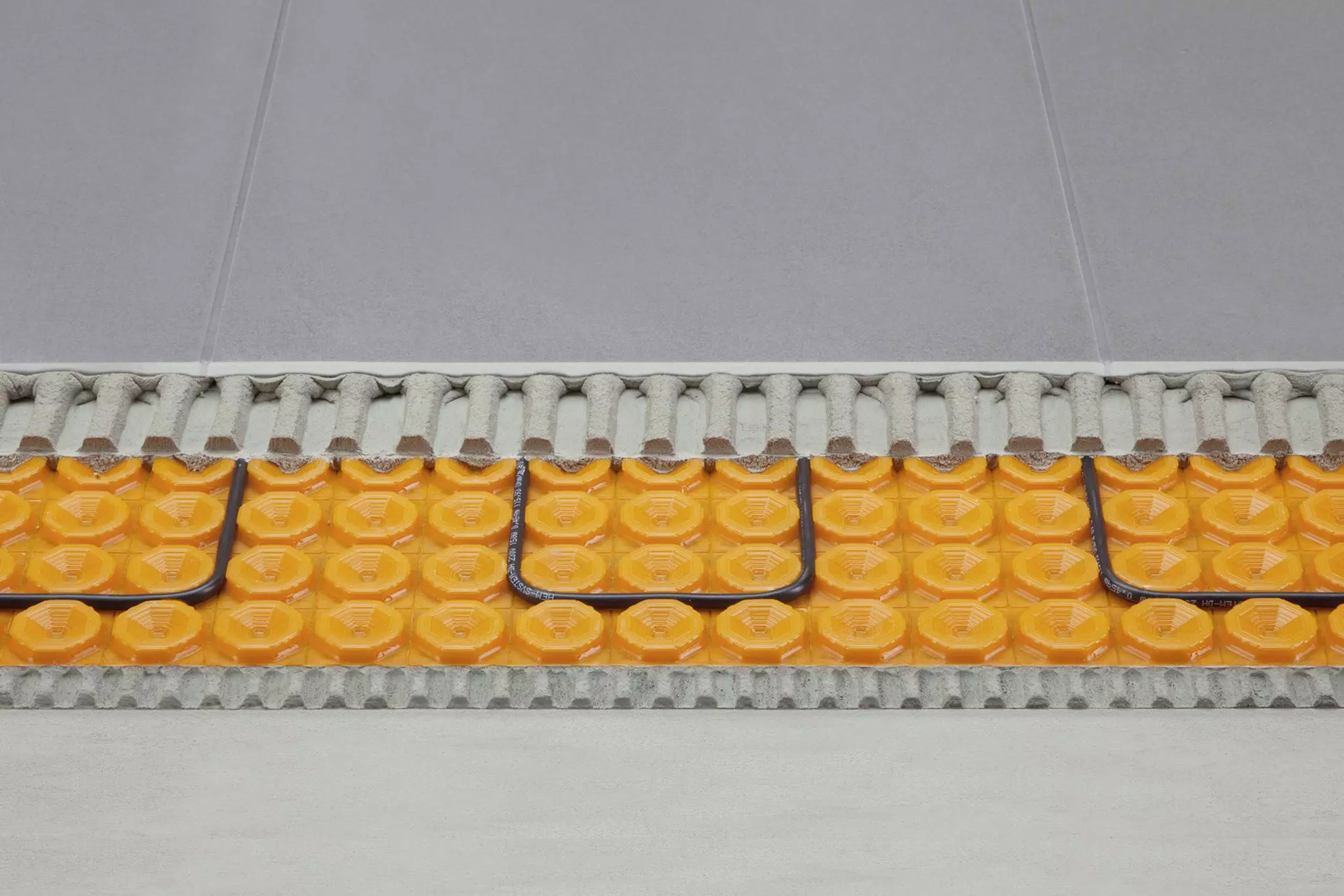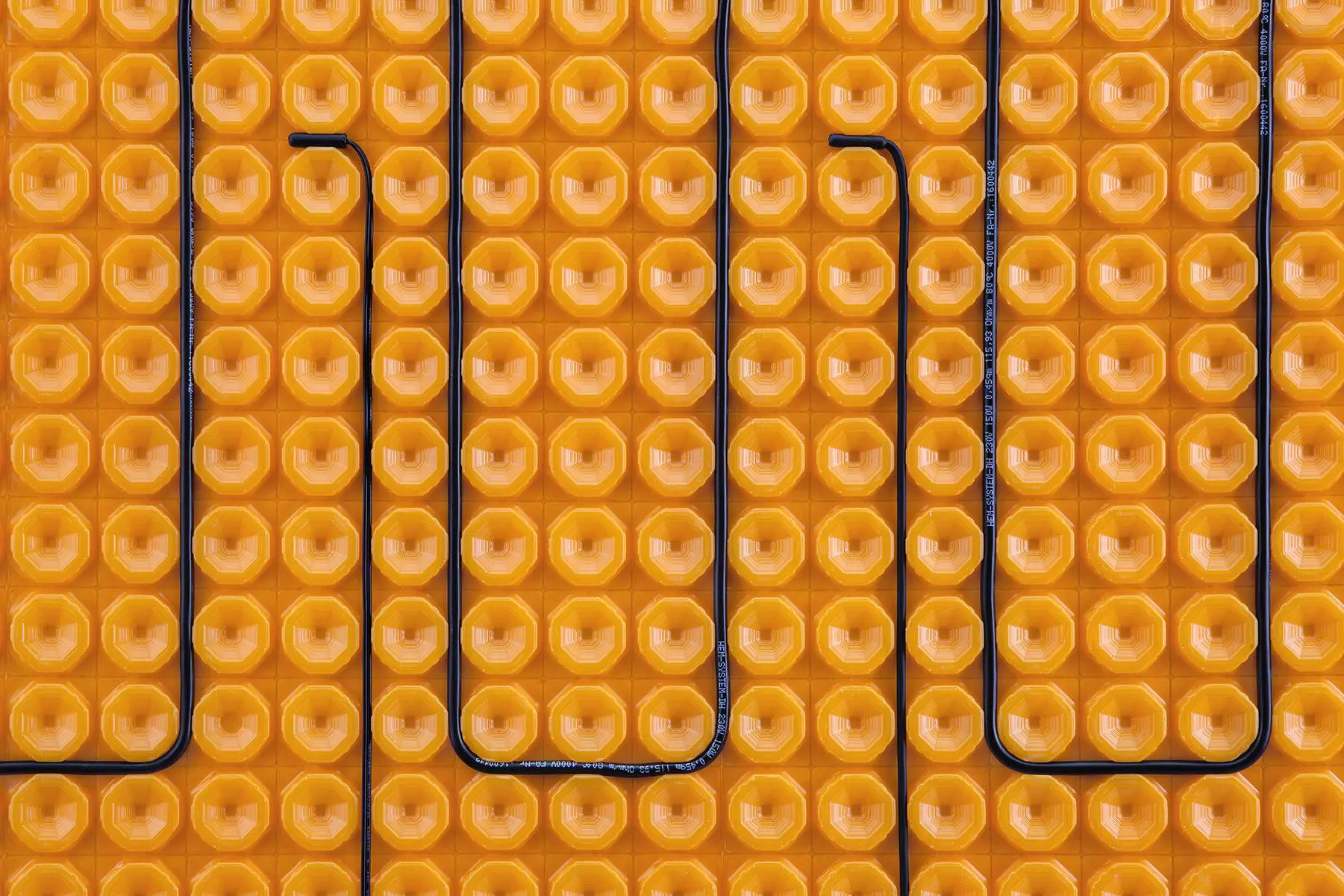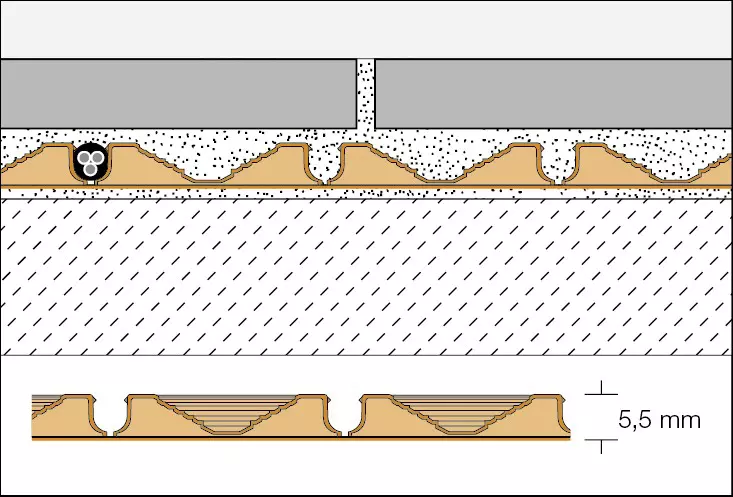The electrical installation must be performed by a qualified electrician in accordance with BS7671. The heating cables must feature a multi pole circuit breaker with a contact clearance of at least 3 mm per pole. To protect against inadvertent contact, an RCD (FI circuit breaker) with a tripping current of IΔN ≤ 30 mA must be installed.
Further information on installing the heating cables and installing and setting up the thermostat can be found in the respective installation instructions.
Positioning the floor sensor
Variant A: The floor sensors are positioned directly in the newly installed uncoupling mat Schlüter-DITRA-HEAT. Since the floor sensor is embedded directly in the cementitious tile adhesive and cannot be replaced, the installation must include a spare sensor (a second sensor is included in thermostat scope of supply as a spare sensor). Place the sensors in the centre between two heating cable loops.
Variant B: Position the floor sensor of the thermostat in the conduit with the sensor sleeve directly in the floor below the DITRA-HEAT uncoupling mat. Cut an opening in the DITRA-HEAT mat in the area of the sensor sleeve. Insert the sensor into the conduit and slide the sleeve over it (conduit and sensor sleeve are available as an installation set, Art.-No. DH EZ S1).
To guarantee an optimal temperature transition from the heated area to the sensor, no insulation material may be located between the sensor sleeve and DITRA-HEAT. In this case, cut an opening in the insulation in the area of the sensor sleeve.
Note: Before embedding the sensors in the cementitious tile adhesive, measure the resistance values, e.g. with the cable tester DITRA-HEAT-E-CT, and compare them with the values listed in the thermostat installation instructions.
- The substrate must be level, load-bearing and free of components that may inhibit bonding. Any necessary levelling work must be completed before installing DITRA-HEAT.
- The selection of the adhesive for installing DITRA-HEAT depends on the substrate.
The adhesive must bond with the substrate and mechanically set in the DITRA-HEAT anchoring fleece. A dry setting cementitious tile adhesive is suitable for most substrates. The adhesive should preferably have a consistency suitable for fluid beds. Review any potential material incompatibilities beforehand. If using covering materials with a side length exceeding 30 cm, we recommend a quick-setting tile adhesive with crystalline water binding capacity for fast curing and drying of the mortar.
- Apply a suitable cementitious tile adhesive on the substrate with a notched trowel (6 x 6 mm). To achieve better initial adhesion for installation in wall areas, we recommend applying a contact layer on the underside of DITRA-HEAT.
- Embed the DITRA-HEAT mats, which must have been cut to size beforehand, into the installed adhesive with the anchoring fleece facing down. Immediately press them in place with a float or roller, working in a single direction. The curing time of the adhesive must be observed. For efficient installation of product rolls, precisely align DITRA-HEAT and keep the material stretched with light tension when placing it on the substrate.
The EasyCut gridlines minimise the curling memory. Mats are recommended for wall applications for easier handling. The mats or membranes are installed with closely abutting joints.
- To prevent any damage to the installed DITRA-HEAT material or detachment from the substrate, protect the area from mechanical stresses, e.g. by setting out running boards (particularly in the centre areas used for material transport).
Heating cable installation
- For installation in floor areas, heating cables may be installed immediately after adhering the uncoupling mat DITRA-HEAT, using a float or roller.
For wall installation, the heating cables are installed once an adequate adhesive bond has been reached.
Heating cables must never overlap or touch each other. - Create a corresponding indentation in the area of the sealed cable end.
Note: Use the cable tester Schlüter-DITRA-HEAT-E-CT to continuously measure the resistance of the electrical heating cables DITRA-HEAT-E-HK. The device monitors the resistance of the heating cables during the entire installation phase and alerts the installer with an acoustic signal in the event of damage.
- Floor areas:
The stud spacing in the uncoupling mat is 3 cm. The installation spacing in the floor area must be
- at least 9 cm (around every third stud – the equivalent of 136 W/m²)
Closer installation spacing - especially in floor areas - may lead to overheating and can cause damage to building structures.
Avoid stepping directly onto heating cables during the installation work.
- Wall areas:
Depending on the available space, the desired surface temperature and the required heat output, the installation spacing in wall areas can either be
- 6 cm (around every second stud – the equivalent of 200 W/m²) or
- 9 cm (around every third stud – the equivalent of 136 W/m²)
- The transition from the heating cable to the connection cable (sleeve) is indicated with a label. The 'cold leg' (4 m) must be connected directly to a junction box or thermostat. The 'cold leg' may be shortened to a max. length of 1 m before the fitting. The heating cables may not be shortened.
- After installing and checking the heating cables as specified in the installation instructions for DITRA-HEAT-E, the tiles can be installed using the thin-set method, with a cementitious tile adhesive that meets the requirements of the respective covering. For maximum efficiency, fill the indentations of the heating mat with the smooth side of a notched trowel (heating cable and fittings must be completely embedded within the tile adhesive) and groove the cementitious tile adhesive with the notched side of the trowel to prepare for tile installation. The notch size of the trowel must match the tile size to completely embed the tiles in the cementitious tile adhesive. Observe the curing time of the adhesive.
- Follow the instructions in the data sheet to install movement joints for perimeter, edge and transition profiles.
Note: The cementitious tile adhesive and the covering material used in conjunction with DITRA-HEAT must be suitable for the respective application area and meet the corresponding requirements. Wait at least 7 days after completing the covering assembly to heat up the DITRA-HEAT-E system for the first time.
Note for installing DITRA-HEAT in wall areas:
To mark the heated wall space (and avoid inadvertent drilling into a heating cable), we recommend using Schlüter profiles (such as RONDEC, QUADEC or DESIGNLINE) to visually outline the corresponding area.
In the case of heated wall areas exceeding a length of 3 m, the wall and connection joints must have a permanently elastic design to accommodate thermal expansion.
Waterproofing with Schlüter-DITRA-HEAT
DITRA-HEAT can be used to create certified waterproofing assemblies with tile coverings, provided the abutting membrane joints and the connections to installed components and upright building structures are carefully sealed.
DITRA-HEAT also features the national technical approval (abP) required in Germany and has an Ü-mark quality seal for construction products. Moisture load class according to abP: 0 - B0 and A.
DITRA-HEAT has a European Technical Assessment (ETA) pursuant to ETAG 022 (watertight covering kits) and bears a CE mark.
Moisture load class according to ETAG 022: A.
System-certified tile adhesives must be used in areas that require CE-compliance or assemblies according to abP (certificate of technical approval).
Please contact us using the details listed at the bottom of this page for further information about such tile adhesive products and the corresponding certificates of technical approval.
DITRA-HEAT protects the substrate from damage caused by permeating moisture and aggressive substances. For seam sealing, trowel the sealing adhesive Schlüter-KERDI-COLL-L over the abutting joints and fully embed Schlüter-KERDI-KEBA in a minimum width of 12.5 cm over the seam.
To waterproof floor-wall transitions, adhere KERDI-KEBA over DITRA-HEAT on the floor and directly on the substrate in wall areas in the corresponding width. The sealing band must have a coverage of at least 5 cm. KERDI-KEBA can also be used to create functional connections to fixed structural components such as door and window frames made of metal, wood or plastic. The first step is to apply Schlüter-KERDI-FIX to the adhesive surfaces of the structural elements. The remaining width is then adhered to DITRA-HEAT with KERDI-COLL-L.
The suitability of KERDI-FIX for the respective materials of the structural elements must be verified in advance. Separate DITRA-HEAT at existing movement joints or expansion joints and seal the abutting joints with Schlüter-KERDI-FLEX. Never run heating cables over expansion joints or dummy joints.
KERDI-FLEX should also be used for flexible finishing edges. As an alternative, this can also be done with a sufficient loop of KERDI-KEBA.
Note on floor drains:
Schlüter-KERDI-DRAIN and Schlüter-KERDI-LINE are a special drainage system designed for connection to bonded waterproofing assemblies. Schlüter-DITRA-HEAT can easily and quickly be combined with these components by using pre-fabricated KERDI collars.
Thermostat:
The heating cables of the DITRA-HEAT system may only be operated with DITRA-HEAT-E thermostats.
Substrates for Schlüter-DITRA-HEAT
Always check that the substrates on which DITRA-HEAT is to be installed are level, load bearing, clean and compatible with the materials to be used. Remove all surface components that may weaken the bond. Any levelling, height adjustment or slope compensation must be carried out before installing DITRA-HEAT.
To guarantee effective floor heating, thermal insulation is required, especially for installations adjoining soil or unheated spaces.
For a faster heat-up response on unheated screed assemblies, we recommend using DITRA-HEAT-DUO for its thermal separation function or Schlüter-KERDI-BOARD as an insulation layer (see data sheet 12.1).
Concrete
Concrete undergoes long-term structural deformation due to shrinkage. In addition, tension can build up in concrete and pre-stressed concrete due to deflection.
Since DITRA-HEAT absorbs the resulting stresses between the concrete and the tile covering, tiles can be immediately installed as soon as the concrete is ready to bear weight.
Cement screeds
In accordance with the applicable regulations, cement screeds must have cured for a minimum of 28 days prior to tile installation and have a moisture content below 2 CM %.
Floating and heated screeds have a particular tendency to buckle and crack even later, e.g. due to mechanical stresses and temperature fluctuations. With DITRA-HEAT, tiles can be installed on green cement screeds as soon as they are ready to bear weight.
DITRA-HEAT will neutralise cracks and screed deformations developing later and will prevent them from affecting the tile covering.
Gypsum based screeds
According to the applicable rules, gypsum based (anhydrite) screed may not have a residual moisture level of more than 0.5 CM % at the time of tile installation. In contrast, tile installation is permissible from a residual moisture level of 2 CM % with DITRA-HEAT.
If necessary, the screed surface must be treated (grinding, priming) as specified by the applicable technical regulations and manufacturer instructions. DITRA-HEAT can be installed with suitable cementitious tile adhesives. DITRA-HEAT protects the screed surface against permeating moisture. Because gypsum based screeds are susceptible to moisture, screeds must be protected against humidity, e.g. moisture seepage on the underside.
Heated screeds
DITRA-HEAT can be used on heated screeds, provided the above notes (cement, gypsum based screeds) are followed. Covering assemblies created with DITRA-HEAT are ready for heating only 7 days after completion. Starting from a temperature of 25 degrees C, the supply temperature can be increased by no more than 5 degrees C a day to a maximum of 40 degrees C.
Note:
Installing DITRA-HEAT over heated screeds makes it feasible to operate an individual, partial heating system that is independent of the central heating system. This allows for completely turning off the central heating system during seasonal transition times.
DITRA-HEAT assemblies can also help cover peak loads.
Vinyl coverings and coatings
All surfaces must be load bearing and pre-treated or suitable for bonding with an appropriate adhesive, in which the DITRA-HEAT anchoring fleece can be embedded. The compatibility of the adhesive with the substrate and with DITRA-HEAT must be verified in advance.
Plywood, chipboard and compressed wood panels
These materials undergo significant deformation based on the influence of moisture (or fluctuations in humidity). It is therefore recommended to use plywood, chipboard and compressed wood panels with special water-repellent treatment to protect against moisture.
Such panels can generally be used as a floor and wall substrate in interior spaces. Refer to local regulations if these are acceptable. However, they have to be thick enough to be sufficiently stable in conjunction with a suitable support assembly.
The structure should be fastened with closely spaced screws. Abutments must have a tongue and groove connection and be fully sealed. Perimeter movement joints of about 10 mm have to be maintained at the transition to upright building structures. DITRA-HEAT neutralises any tensions with the tile covering and also prevents permeating moisture.
Hardwood floors
In principle, ceramic coverings can be installed on sufficiently weight bearing hardwood floors with tongue and groove connections. The wooden substrate should have balanced moisture levels before DITRA-HEAT can be installed. It has proven beneficial to install an additional layer of plywood. Uneven floor surfaces should be levelled with suitable measures beforehand.
Masonry / mixed substrates
Masonry structures built with bricks, sand lime bricks, cement blocks, aerated concrete or similar materials are generally a suitable substrate for DITRA-HEAT. The substrate must be levelled in advance. In restoration and refurbishment projects, substrates frequently consist of different materials (mixed masonry), which have a tendency to crack at the interfaces with other materials due to different deformation rates. DITRA-HEAT protects the tile covering from the resulting tensions and cracks.
Gypsum plaster / bricks
Gypsum substrates should be completely dry in accordance with the relevant regulations. The surfaces may need to be pre-treated with a primer. DITRA-HEAT can be installed with dry-setting or other suitable cementitious tile adhesives.







